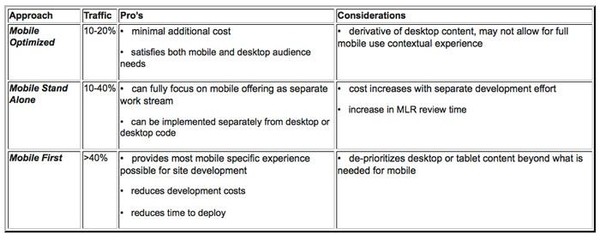Commentary
Examining Your Options For Building Mobile Sites For Patients And HCPs
- by Geoff McCleary , June 14, 2013
We know that patients and healthcare professionals are using mobile devices for health and wellness information. In fact, 80% of physicians own a mobile phone, and 68% of them have at least two screens (smartphone and tablet). But many health and wellness brands have been slow to adopt mobile strategies, and have instead relied on the desktop experience to translate to a shrunken screen.
Findings from recent studies conducted by Google and Manhattan Research may accelerate the industry’s mobile enthusiasm. The research revealed the alarming reality that 62% of physicians are likely to abandon mobile websites that are not mobile-optimized. That coupled with the reality that 52% of smartphone owners have looked up health and fitness information from their mobile devices raises the urgency with which health and wellness brands need to build and provide mobile-optimized content.
In the past, because of low mobile-originated traffic and limited browser technology, mobile web approaches were typically not considered for brand sites, and development was limited to the desktop build. Fortunately, pharma marketers have a number of options to choose from when providing patients and HCPs with a web experience on their mobile devices.
advertisement
advertisement
As mobile browsers improved, and the approach stayed the same, we saw the emergence of the mobile viewable pharma site. Mobile Viewable sites were legacy pre-mobile sites that had been developed solely for desktop use, but could be viewed and interacted with on a mobile device. The experience often ranged from poor to barely usable, as not all parts of the sites were completely functional or able to be accessed on the device.
Luckily, our options have improved and we can view mobile sites with better browsers and build sites with more mobile focused technology and tools. So today, our patient and HCP build options are based on a combination of where we start the build (desktop, mobile, or both) and where we need to be primarily viewed (desktop, mobile, or both).
Once you have determined the appropriate mobile strategy and experience, and it’s time to decide on your build approach, you as pharma marketers have three options: Mobile Optimized, Mobile Stand Alone, and Mobile First.
Mobile Optimized sites are developed and coded for the desktop, but developed with an understanding that desktop content will be accessed on a mobile device by a significant number of visitors. Mobile Optimized sites may include mobile specific navigation, layout and content changes to accommodate things like touch access or mobile specific contextual use, which can all be added to desktop based html and code with custom style sheets (CSS) and additional mobile scripting as needed.
Mobile Stand Alone, or dedicated mobile sites, may be an appropriate choice for your development when your mobile experience strategy indicates the need for mobile specific functions or content that will be a significant departure from the desktop experience. While the mobile site may end up with a similar look and feel to the desktop site, they are built and hosted as completely separate sites. This most frequently occurs when either the mobile use case is completely different from the desktop use case, and wouldn't leverage any of the content from the desktop experience, or when native device functionality is needed. In some cases, it may be easier to have separate sites approved through regulatory review than to leverage one build for both desktop and mobile.
Mobile First sites are built when you know that 50% or more of your audience will be coming to your site via mobile browser and a desktop experience is not a priority for your audience. In this case, the approach is the reverse of the Mobile Optimized approach as the strategy and user experience will focus solely on the mobile site and will leverage CSS changes to make the site viewable on desktop browsers.
Considerations for
when to make to choose each are below:


